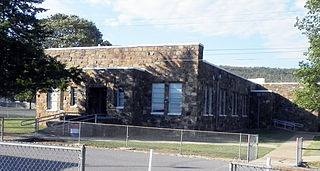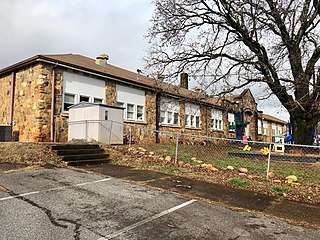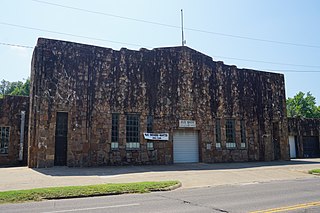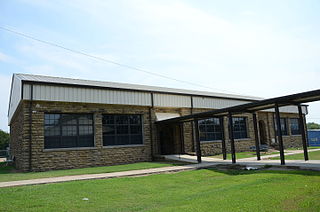
Sequoyah's Cabin is a historic log cabin and historic site off Oklahoma State Highway 101 near Akins, Oklahoma. It was the home between 1829 and 1844 of the Cherokee Indian Sequoyah, who in 1821 created a written language for the Cherokee Nation. The cabin and surrounding park, now owned by the Cherokee Nation, was declared a National Historic Landmark in 1965.

Clayton High School Auditorium is an historic structure serving the public school of Clayton, Oklahoma. Clayton is located in the Kiamichi Mountains of Pushmataha County, Oklahoma.

The Webster Rock School is an historic school building located NC 116 / Main St., at Webster, Jackson County, North Carolina. It was built between 1936 and 1938 by the Works Progress Administration, and is one story with hip roof utilitarian building, constructed of native "river rock" in colors of tan and brown. It has an "E"-shape plan and has a 13 bay front facade. The school originally contained an auditorium, cafeteria, kitchen and eight classrooms.

Ashwood School Gymnasium and Auditorium is a historic school gymnasium and auditorium located near Bishopville, Lee County, South Carolina. It was built in 1938 to serve Ashwood Plantation, the first and largest of the Resettlement Administration (RA) project tracts in South Carolina. The building served as the school and community gymnasium and as an auditorium for dramatic performances and films. It is a one-story building with a simplified Colonial Revival style popular in the 1930s in government-sponsored construction.

Church Street School is a historic school building for African-American students located at Thomasville, Davidson County, North Carolina. It was built in 1935–1937, and is a two-story, "T"-shaped, Colonial Revival style brick building. A two-story auditorium projects from the rear of the main building. Two-story wings built in 1951 flank the original building. A gymnasium was built the same year. Some funding for school construction was provided by the Public Works Administration.

The Horace Mann School Historic District of Norfork, Arkansas encompasses a complex of four Depression-era school buildings near the center of the community. It includes a main school building, built with Works Progress Administration (WPA) funding in 1936, a home economics building and a vocational educational building, both built in 1937 by the National Youth Administration, and the auditorium/gymnasium, built in 1940 with WPA funds. All are single-story Craftsman-style buildings, although the gymnasium presents more stories because of a partially exposed basement. The complex was used as a school until the mid-1980s, and is now owned by the city, which uses the buildings for a variety of purposes. It is a well-preserved and remarkably complete Depression-era school complex.

The Keel Creek Bridge is a bridge on Oklahoma State Highway 31 seven miles northeast of Coalgate, Oklahoma. The bridge is listed on the National Register of Historic Places. It was constructed as a Works Progress Administration project. The bridge is significant because of its importance to the transportation history of the area and because it is a WPA-built structure.

The United States Post Office Coalgate is a post office in Coalgate, Oklahoma. It contains a mural, Women Making Pishafa, painted by artist Acee Blue Eagle. The post office is listed on the National Register of Historic Places.

Yancey Collegiate Institute Historic District is a historic school complex and national historic district located at Burnsville, Yancey County, North Carolina. The district encompasses seven contributing buildings, one contributing structure, and one contributing object built between 1914 and 1955. Contributing resources include the Brown Dormitory for Boys (1914), (Former) Burnsville High School Gymnasium, an outdoor amphitheater (1950-1952), the Classical Revival style (Second) Administration Building for Yancey Collegiate Institute, Gymnasium, former Burnsville High School built by the Works Progress Administration (1939) and a stone retaining wall. The Yancey Collegiate Institute (YCI) was established in 1901 and sponsored by the Baptist church. The YCI educated students until 1926, when the facilities were sold to the Yancey County Board of Education.

The Arkoma School in Arkoma in Le Flore County, Oklahoma was a Works Progress Administration-funded project completed in 1937. It was listed on the National Register of Historic Places in 1988.

The Dog Creek School, near Shady Point, Oklahoma, is a one-room school built in 1936 as a Works Progress Administration project. It was listed on the National Register of Historic Places in 1988.

The Poteau Community Building, in Poteau in Le Flore County in southeastern Oklahoma, is a multipurpose community building built as Works Progress Administration project in 1937. It was listed on the National Register of Historic Places in 1988.

The Tucker School was a three-room schoolhouse built in 1937 as a Works Progress Administration project in a rural area outside of Spiro in LeFlore County, Oklahoma. It was listed on the National Register of Historic Places in 1988.

Twyman Park, on West Street in Poteau in Le Flore County, Oklahoma, has structures built in a Works Progress Administration project in 1937. It was listed on the National Register of Historic Places in 1988.

The Shady Point School, located on the northeastern edge of the community of Shady Point in Le Flore County, Oklahoma, was built in 1936 as a Works Progress Administration project. It was listed on the National Register of Historic Places in 1988.

The Poteau School Gymnasium-Auditorium, located at Walter and Parker Sts. in Poteau in Le Flore County, Oklahoma, was built in 1937. It was listed on the National Register of Historic Places in 1988.

The Idabel Armory in Idabel, Oklahoma was built in 1936 as a Works Progress Administration (WPA) project. It was listed on the National Register of Historic Places in 1988.

The Robert E. Lee School, at Ninth and Louisiana Streets in Durant, Oklahoma, was built in 1937. It was listed on the National Register of Historic Places in 1988.

The Kinta High School, on OK 2 in Kinta, Oklahoma, was built with Works Progress Administration funding in 1936. It was listed on the National Register of Historic Places in 1988.

The Brandon Auditorium and Fire Hall, on Holmes Ave. in Brandon, Minnesota, is a historic fire station and other facility. It has also been known as the Brandon Auditorium and City Hall. It was built as a Works Progress Administration project during 1935–36. It was listed on the National Register of Historic Places in 1985.


















